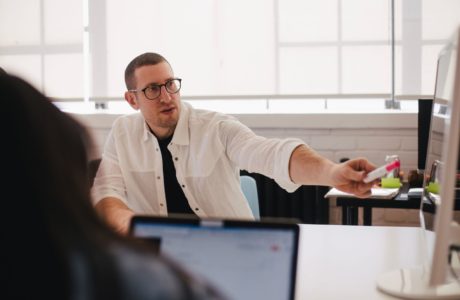Are we actively participating in creating a better future? Here are 7 dimensions to help navigate the Future of Work.
In this article I will not be referencing any quotes or statistics. Nor will I be sharing stories about robots or fantasy futures. Instead, I’ll be sharing practical considerations for how organizations of all sizes can actively engage in shaping the Future of Work today by simply putting humans at the centre of conversations and creating the conditions to unlock their potential.
Work is changing, are you?
The radical disruption of work—as a catalyst for and as a result of change—has profound systemic and social implications. Navigating an unpredictable, rapidly evolving, and complex Future of Work is a challenge that every organization is facing today.
Although at the forefront of change, “work” is not the only entity at play in the “Future of Work.” While automation, blockchain, AI, and robotics are some of the technologies that are constantly and fundamentally shaping and reshaping our economic and social systems, so too are globalization and demographic shifts, and a dozen other drivers.
Organizations are a fundamental component of our economic system, society, and human experience. And leading organizations are expanding the value they deliver beyond shareholder value; they are starting to place equal importance on the human, social, and economic impact they create inside the organization and out in the world. If we want to truly affect change, however, we have to increase the scope and speed at which these changes are happening
Organizational leaders in the Future of Work are fostering a deep focus on purpose, impact, and value creation. They achieve this by encouraging a sense of well-being for all of their stakeholders and by offering human-centered products, services, and experiences to their customers. They are acting and sensing in new ways, as the future emerges all around us.
What does it mean to create a Future of Work that works for its humans?
I have been exploring this question for the last couple of years talking to many thought leaders in the space, interviewing practitioners and designers, and hosting discussions on this topic. I have come to the following conclusion: To answer this question, organizations need to shift their efforts from trying to figure out “What will the Future of Work be?” to “How are organizations navigating the Future of Work?”
Organizations who navigate the Future of Work, rather than predict it, go from simply observing possible futures, to being an active participant in shaping, and responding to, those emerging futures.
It’s a simple but fundamental shift in perspective. Organizations who navigate the Future of Work, rather than predict it, go from simply observing possible futures, to being an active participant in shaping, and responding to, those emerging futures.
How these considerations are addressed—and which of them is given priority—will vary by organization and by industry. There is no recipe or blueprint for how to do this; but as an organization, you have to invest in exploring these dimensions that makeup the Future of Work if you want to stay ahead and respond to changing conditions.
Regardless of how each organization approaches the emerging challenges, the following dimensions are all vital to running a thriving organization.
7 Dimensions to navigate the Future of Work.
Regardless of how each organization approaches the emerging challenges, the following dimensions are all vital to running a thriving and responsive organization.

Self-management is the leading corporation.
The current capacity to dynamically sense and respond to change within traditional organizations is limited. Simply put, the world is too complex for the old ways of working and organizing. Conventional management hierarchy and tired forms of leadership cannot support sustainable thriving businesses and communities any further.
With the autonomy it offers and the human wholeness it requires, self-management distributes decision making abilities across the system, brings integrity and transparency forward, and most of all releases individual power into the organization. This shift supports the people and the organization in pursuing purpose.
AI is the new stakeholder.
As we shift to a world increasingly run by Artificial Intelligence and Machine Learning operations, customer and employee experiences are changing—drastically. Organizations have a critical role in designing the customer interactions with their products and services, but also in designing the relationship between humans and machines in the workplace.
Collaboration between workers and AI can make or break the organization of the future. For this human-machine relationship to succeed, it will be essential for organizations to create conditions for a symbiotic relationship where machine and human systems can build upon one another, elevating the potential of both parties to new heights.
Ethics are an integral part of the Value Proposition.
As governments and regulators struggle to cope with the exponential pace of change, organizations must be held accountable for the decisions they and their machines make.
Machine-learning models will have—and are already having—an impact on our lives. These human-generated models will inevitably reflect the same biases that we have as a society if this isn’t carefully avoided.
Ethics must be embedded in the design process from creation to implementation to thoughtfully curate our future. Organizations need to articulate their intentions and leverage AI to focus on improving the quality of work, provide access, and generate and distribute more wealth for a fair and equitable approach.
Empathy is a core value of the workplace.
At a time when many organizations are going digital and implementing more automated systems, we are in ever greater danger of losing our human sense. We’ve already designed our “normal” work environments in such a way that the person is disconnected from the work environment.
In order to create a Future of Work in which everyone thrives, organizations must nurture a sense of care and invest in an organization design and culture where people come first. This requires a level of emotional insight, and therefore, an investment in the people and their well-being beyond the immediate needs of the job.
Learning is the job.
According to the World Economic Forum’s 2020 Future of Jobs report, “Cognitive Flexibility” is among the top 10 skills needed to succeed in the Future of Work. What does this mean? To thrive in a future that is unfolding faster than we can imagine it, we must become adept at learning continuously. The models of learning are changing and organizations will play a major role in enabling a scaffolding approach to learning.
Learning doesn’t happen upfront anymore; the organization of the future must become a platform that facilitates learning at various stages throughout a person’s career. Additionally, fostering a culture of giving and receiving feedback and coaching in the pursuit of business excellence and the growth of people makes people development and business development all part of the same growth mindset: what is good for the individual’s growth, is good for the organization’s growth, and vice versa.
Transitions are the strategic pathway.
The nature of work in many industries will change significantly as the markets, organizations, and occupations are constantly being reshaped in combination with new technologies within dynamic conditions. It is harder than ever to predict and prepare as workers, employers, educators, policymakers, organizations, institutions, and governments. There is no single “right” scenario to plan, and no one strategy to win them all; rather, organizations need to quickly build adaptive capacity for ongoing change. Adaptive, responsive organizations are the ones who will thrive in the future.
Circular thinking is the established benchmark.
As the scale and scope of corporate responsibility transcends organizational boundaries and into economic systems, circular thinking is becoming the new norm. Seeing the world at multiple scales, from multiple perspectives, as an unfolding emergent process will help organizations change how they source, create, capture, and distribute value. Designing our organizations and value propositions as circular and purposeful businesses is the path to long-term stakeholder value creation. Circular thinking is a systemic shift that builds resilience, generates opportunities, and provides economic, environmental, and societal benefits.
We’re looking at one of the greatest organizational design challenges of our lifetime. The future world of work is bright and ever-changing, it thrives and succeeds if, and only if, organizations and leaders actively shape the future with our societies and all its humans in mind. The Future of Work must be human first.
Let’s keep asking ourselves and others: Are we actively participating in creating a better future? Is the future we are creating good? Does it make people’s lives better?









